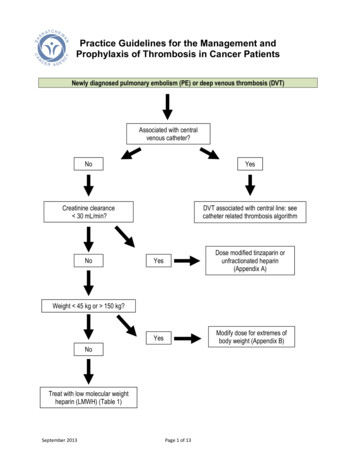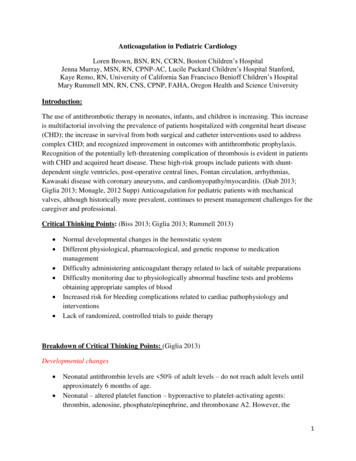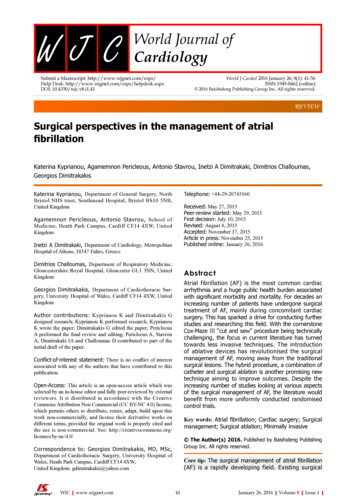
Transcription
Practice Guidelines for the Management andProphylaxis of Thrombosis in Cancer PatientsNewly diagnosed pulmonary embolism (PE) or deep venous thrombosis (DVT)Associated with centralvenous catheter?NoYesCreatinine clearance 30 mL/min?DVT associated with central line: seecatheter related thrombosis algorithmNoYesDose modified tinzaparin orunfractionated heparin(Appendix A)YesModify dose for extremes ofbody weight (Appendix B)Weight 45 kg or 150 kg?NoTreat with low molecular weightheparin (LMWH) (Table 1)September 2013Page 1 of 13
Saskatchewan Cancer AgencyPractice Guidelines for the Management and Prophylaxis of Thrombosis in Cancer PatientsRecommendations for initial treatment of established VTE1. Low molecular weight heparin (LMWH) is recommended for treatment of establishedVTE in cancer patients (Table 1) who have no contraindications to systemicanticoagulation (Table 2).2. The use of vitamin K antagonists (VKAs) are not recommended in this patientpopulation due to inferior efficacy.3. The use of new oral anticoagulants is not recommended in this patient populationdue to lack of data.Table 1: Preparations and dosage of anticoagulation for initial treatmentLMWH1DalteparinDosage200 IU/kg SC once dailyTinzaparin175 IU/kg SC once dailyEnoxaparin1 mg/kg SC twice dailyUnfractionated heparinAs per protocolLevel of EvidenceExcellent: recommended for usein this population1Very good: recommended for usein this population2Limited: no specific trial showingbenefit in this populationBased on historical dataLee et al. Low-molecular-weight heparin versus a coumarin for the prevention of recurrent venous thromboembolism inpatients with cancer. N Engl J Med. 2003 Jul 10;349(2):146-53.2Hull et al. Long-term low-molecular-weight heparin versus usual care in proximal-vein thrombosis patients with cancer. AmJ Med. 2006 Dec;119(12):1062-72.Table 2: Relative contraindications to thromboprophylactic or therapeuticanticoagulation therapy from the National Comprehensive Cancer Network(NCCN) Recent central nervous system bleed, intracranial or spinal lesion at high risk for bleedingActive major bleeding requiring blood transfusion or chronic clinically significant bleedingThrombocytopenia (platelets 50 x 109/L)Severe platelet dysfunction (uremia, medications, dysplastic hematopoiesis)Recent major operation at high risk for bleedingUnderlying coagulopathy due to clotting factor abnormalities, elevated prothrombin time (PT/INR) oractivated partial thromboplastin time (aPTT), excluding lupus inhibitorsSpinal anesthesia or lumbar punctureHigh risk for fallsSeptember 2013Page 2 of 13
Saskatchewan Cancer AgencyPractice Guidelines for the Management and Prophylaxis of Thrombosis in Cancer PatientsTable 3: Availability and cost of out-patient pre-loaded syringes and multi-usevialsLMWHDalteparin(Fragmin )Dosage FormCost/syringePreload syringe2,500 units/0.2 mL5,000 units/0.2 mL7,500 units/0.3 mL10,000 units/0.4 mL12,500 units/0.5 mL15,000 units/0.6 mL18,000 units/0.72 mL 5.58 40.14 40.14 40.14 40.14 40.14 40.14Single use vial10,000 units/mL solution 1 mL vialMulti use vial25,000 units/mL solution 3.8 mLvialTinzaparin(Innohep )Enoxaparin(Lovenox )15,000 units once daily 1394.61 17.6115,000 units once daily 927.96 167.2415,000 units once daily 927.66Preload syringe2,500 units/0.25 mL3,500 units/0.35 mL4,500 units/0.45 mL10,000 units/0.5 mL14,000 units/0.7 mL18,000 units/0.9 mL 7.78 7.78 7.78 32.19 32.19 32.19Multi use vial10,000 units/mL solution 2 mL vial20,000 units/mL solution 2 mL vial 34.72 70.53Preload syringe30 mg/0.3 mL40 mg/0.4 mL60 mg/0.6 mL80 mg/0.8 mL100 mg/1 mL120 mg/0.8 mL150 mg/1 mL 6.72 22.25 22.25 22.25 22.25 33.37 33.37Multi use vial100 mg/mL solution 3 mL vial 66.73* Examples using a therapeutic dosage and weight of 75-80kgSeptember 2013Example Cost for 1 Month(34 days) as of May 2013*Page 3 of 1314,000 units once daily 1124.3114,000 units once daily 856.1914,000 units once daily 869.1680 mg twice daily 1542.85120 mg once daily 1164.4380 mg twice daily 1239.89120 mg once daily 937.38
Saskatchewan Cancer AgencyPractice Guidelines for the Management and Prophylaxis of Thrombosis in Cancer PatientsRecommendations for initial treatment in patients with established VTE andspecial circumstancesRenal impairment1. Consider hematology consult in patients with creatinine clearance 30 mL/hour dueto complexity of monitoring and potential complications. Suggested dosing andmonitoring guidelines can be found in Appendix A.2. Tinzaparin can be used for patients with creatinine clearance 20 mL/hour atregular dosing (175 IU/kg sub-cu once daily) based on clinical data.3. Unfractionated heparin can be offered to in-patients with renal impairment(creatinine clearance 30 mL/hour) as per pharmacy provided VTE protocols withaPTT monitoring.4. Enoxaparin and dalteparin are not recommended in patients with renal impairmentdue to lack of clinical data.Extremes of body weight1. Patients with actual body weight of 150 kg or 45 kg require monitoring with antiXa levels. Consideration of hematology consultation is recommended due tocomplexity of monitoring and potential complications. Suggested dosing andmonitoring guidelines can be found in Appendix B.Other special circumstances1. In patients who have a history of heparin induced thrombocytopenia (HIT) or aresuspected to have HIT, fondaparinux can be used for the initial treatment ofestablished VTE.2. Thrombolysis in cancer patients with established VTE may only be considered on acase-by-case basis, with specific attention paid to contraindications, especiallybleeding risk (for example, due to brain metastasis).3. In the initial treatment of VTE, vena cava filters may be considered in the case ofcontraindication for anticoagulation or in the case of pulmonary embolism recurrenceunder optimal anticoagulation. Periodic reassessment of contraindications foranticoagulation is recommended and anticoagulation should be resumed when safe.Vena cava filters are not recommended for primary VTE prophylaxis in cancerpatients.4. In patients with active VTE and critically low platelets (platelets 30 x 109/L),anticoagulation may be either held or platelet transfusion administered to maintainthe platelet count 30 x 109/L.5. In patients receiving treatment for malignancy with non-curative intent who developactive VTE, initial treatment with unfractionated or low molecular weight heparin isrecommended.September 2013Page 4 of 13
Saskatchewan Cancer AgencyPractice Guidelines for the Management and Prophylaxis of Thrombosis in Cancer PatientsRecommendations for ongoing management of established VTE1. LMWHs are the recommended treatment for a minimum of 6 months after diagnosisdue to improved efficacy over VKAs. Recommended doses can be found inTable 1.12. Anticoagulation with LMWH or VKA may be considered beyond the initial six monthsfor select patients after evaluation of ongoing risk factors for development ofthrombosis (i.e. immobility, hormonal adjuvant therapy etc), benefit-risk ratio,tolerability and patient preference.3. Ongoing anticoagulation is preferred in patients who continue to have activemalignancies.4. The benefit of LMWHs versus VKAs beyond six months of therapy for newlyestablished venous thrombosis has not been proven. The continued use of LMWHbeyond six months should include such factors as economic cost, quality of life (i.e.daily injections versus a pill), and the inability or ability to access monitoring (INR).5. LMWH is contraindicated with an estimated GFR less than 20 cc per minute. Theuse of UH bridged to VKAs with a goal INR of 2-3 in this context is recommended.6. There is insufficient clinical data to support the use of new oral anticoagulants in thispatient population.Treatment of VTE recurrence in cancer patients on anticoagulation1. In the event of VTE recurrence in patients already on anticoagulation, three optionscan be considered:a. Switch from VKA to LMWH in patients on therapeutic dose of VKA.b. Increase in LMWH dose by 25% in patients treated with LMWH.c. Vena cava filter insertion in select circumstances (evidence of efficacygenerally low).2. Consideration may be given to consulting hematology in this situation.1To acquire EDS status, call 306-787-8744 and state that the patient has a contraindication to warfarintherapy due to active chemotherapy treatment. This status is updated on the provincial pharmacydatabase and will be available at the local pharmacy when the prescription for LMWH is filled.September 2013Page 5 of 13
Saskatchewan Cancer AgencyPractice Guidelines for the Management and Prophylaxis of Thrombosis in Cancer PatientsCatheter related thrombosis (CRT)Established catheter-related thrombosis1. For the treatment of symptomatic CRT in cancer patients, anticoagulant treatmentwith LMWH is recommended for a minimum of 3 months.2. The central venous catheter (CVC) can be kept in place if it is functional, wellpositioned and not infected.3. Close surveillance for resolution of symptoms is recommended; if symptoms persistdespite appropriate treatment, the CVC may require removal.4. It may be appropriate to extend anticoagulation beyond 3 months in the absence ofrecanalization and in the context of progressive disease.5. Use of anticoagulation for routine prophylaxis of CRT is not recommended.September 2013Page 6 of 13
Saskatchewan Cancer AgencyPractice Guidelines for the Management and Prophylaxis of Thrombosis in Cancer PatientsProphylaxis of VTE in cancer patientsHospitalized patient with malignancy or strongsuspicion of malignancyAny contraindication toanticoagulation?YesNoMechanical prophylaxis / earlymobilization / clinical surveillanceProceed with prophylaxisConsider dose modification for Renal impairment (Appendix C) Extremes of body weight(Appendix D)September 2013Page 7 of 13
Saskatchewan Cancer AgencyPractice Guidelines for the Management and Prophylaxis of Thrombosis in Cancer PatientsProphylaxis of VTE in cancer patientsProphylaxis in hospitalized patients with cancer1. Prophylaxis is recommended for all hospitalized patients with cancer who do nothave a relative contraindication to anticoagulation (Table 2).2. Either LMWH or UFH can be used at prophylactic doses (Table 6).3. Dose modification should be considered in renal insufficiency and extremes of bodyweight (Appendices C and D).Table 6: Recommended doses of prophylactic anticoagulantsProphylactic ionated heparinRecommended dose5000 IU SC once daily40 mg SC once dailyor 30 mg SC twice daily4500 IU SC once daily or 75 IU/kg SC once daily5000 IU SC three times dailyProphylaxis in cancer patients following surgery1. Use of LMWH once a day or a low dose of UFH three times a day is recommended.There is no data allowing conclusions regarding the superiority of one type of LMWHover another (Table 5).2. Prophylaxis should be started 12-24 h postoperatively and continued for duration ofhospitalization.3. Extended prophylaxis (4 weeks) to prevent postoperative VTE after majorlaparotomy in cancer patients should be considered in patients with a high VTE riskand low bleeding risk.4. The use of LMWH for the prevention of VTE in cancer patients undergoinglaparoscopic surgery may be recommended in the same way as for laparotomy.5. Mechanical methods alone are not recommended except when pharmacologicalmethods are contraindicated.Prophylaxis for cancer patients not in hospital1. In outpatients with cancer who have no additional risk factors for VTE, we suggestagainst routine prophylaxis with LMWH, low dose UFH or vitamin K antagonists.2. In outpatients with solid tumors who have additional risk factors for VTE (Table 7)and who are at low risk of bleeding, prophylactic dose LMWH or low dose UH shouldbe considered.3. Routine prophylaxis is not recommended for chronically immobilized cancer patientsnot in hospital.September 2013Page 8 of 13
Saskatchewan Cancer AgencyPractice Guidelines for the Management and Prophylaxis of Thrombosis in Cancer PatientsTable 7: Additional risk factors for venous thrombosis in cancer outpatients Previous venous thrombosisImmobilizationHormonal therapyAngiogenesis inhibitors [e.g. bevacizumab (Avastin )]Regimens containing thalidomide, lenalidomide or pomalidomideMetastatic pancreatic cancerMetastatic lung cancerSeptember 2013Page 9 of 13
Saskatchewan Cancer AgencyPractice Guidelines for the Management and Prophylaxis of Thrombosis in Cancer PatientsAppendix ADosing and monitoring guidelines for treatment of VTE in patients with ance 20 mL/min10-20 mL/minDose175 IU/Kg SC once dailyAs per hospital protocolEnoxaparinNot recommended due tolack of clinical dataDalteparinNot recommended due tolack of clinical dataMonitoringNoaPTTTarget LevelNoAs per hospitalprotocolThe preference of this committee is to use tinzaparin for patients with creatinine clearance 20 mL/min as it is betterstudied in this population and does not require monitoring.September 2013Page 10 of 13
Saskatchewan Cancer AgencyPractice Guidelines for the Management and Prophylaxis of Thrombosis in Cancer PatientsAppendix BDosing and monitoring guidelines for treatment of VTE in patients with extremesof body weightBody WeightActual BodyWeight 150 kgPreparation /DoseUH as per VTE protocolEnoxaparin1 mg/kg SC q12hUse adjusted body weight*Minimum initial dose is150 mg SC q12h. Do not usesingle-daily dosing regimenTinzaparin175 IU/kg SC if BMI 40kg/m2MonitoringPTTTarget Levelx 2 - 2.5 baseline PTTAn anti-Xa levelshould be obtained4 hours after the 1st or2nd dose andsent STAT to thelabTitrate dose tomaintain ananti -Xa level of0.5 - 1 units/mLTitrate dose tomaintain ananti -Xa level of0.5 - 1 units/mLDalteparin200 IU/kg SC q24hActual BodyWeight 45 kgUH as per VTEProtocolPTTEnoxaparin1.5 mg/kg SC q24hactual body weightanti-Xa levelshould be obtained 4hours after the 3rd AMdose and sent STATto the labTitrate dosage tomaintain ananti-Xa level of1 - 1.5 units/mLTinzaparin175 IU/kg SC q24h actualweightTitrate dose tomaintain ananti -Xa level of0.5 - 1 units/mLDalteparin200 IU/kg SC q24h actualbody weightTitrate dose tomaintain ananti -Xa level of1 - 2 units/mL* Adjusted body weight Ideal BW 0.4 (Actual BW – Ideal BW)Ideal BWMen:50 kg 2.3 kg (height in cm - 152.4)2.54Women: 45.5 kg 2.3 kg (height in cm - 152.4)2.54September 2013Titrate dose tomaintain ananti -Xa level of1 - 2 units/mLx 2-2.5 baseline PTTPage 11 of 13
Saskatchewan Cancer AgencyPractice Guidelines for the Management and Prophylaxis of Thrombosis in Cancer PatientsAppendix CDosing and monitoring guidelines for prophylaxis of VTE in patients with renalfailurePreparationUnfractionated HeparinCreatinine clearance (mL/min) 30 mL/minDose/route5000 IUSC q8hrTinzaparin 30 mL/min4500 IU SC once dailyDalteparin 30 mL/min2500-5000 IU SC once dailyEnoxaparin 30 mL/min40 mg SC once daily(Note: limited data to support use inthis population)September 2013Page 12 of 13
Saskatchewan Cancer AgencyPractice Guidelines for the Management and Prophylaxis of Thrombosis in Cancer PatientsAppendix DDosing and monitoring guidelines for prophylaxis of VTE in patients withextremes of body weightPreparationBody WeightDose/RouteMonitoringTargetUH 45 kg 150 kgActual BodyWeight 45 kg5000 units SC tid5000 IU SC q8h40 mg SC q24hNoNoTitrate dosage tomaintain anti-Xalevel of 0.5 units/mLBMI 40 kg/m2 45 or 150 kgActual BodyWeight 50 kg40 mg SC q12h4500 IU SC q24h5000 IU SC q24hBMI 40 kg/m2Weight 150 kg5000 IU SC q12h7500 IU SC q12hNoNoanti-Xa levelshould beobtained 4 hoursafter the 7th AMdose and sentSTAT to the labNoNoanti-Xa levelshould beobtained 4 hoursafter the 7th AMdose and sentSTAT to the labNoanti-Xa levelshould beobtained 4 hoursafter the 7th AMdose and sentSTAT to the labEnoxaparinTinzaparinDalteparinSeptember 2013Page 13 of 13NoNoTitrate dosage tomaintain anti-Xalevel of 0.4 units/mLNoTitrate dosage tomaintain anti-Xalevel of 0.4 units/mL
Newly diagnosed pulmonary embolism (PE) or deep venous thrombosis (DVT) DVT associated with central line: see catheter related thrombosis algorithm Associated with central venous catheter? Yes No Creatinine clearance . Prophylaxis should be started 12-24 h postoperatively and continued for duration of hospitalization. 3. Extended prophylaxis .











